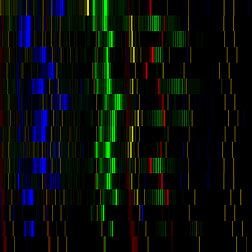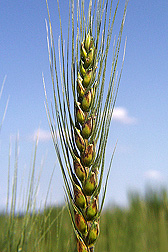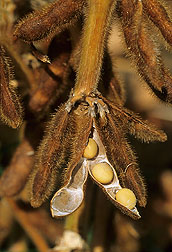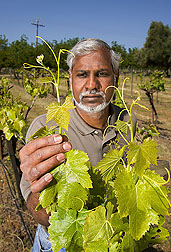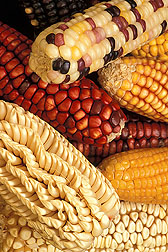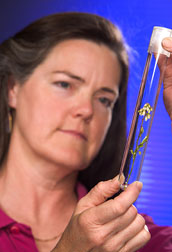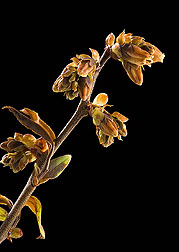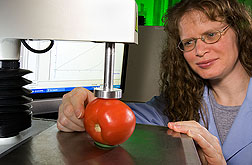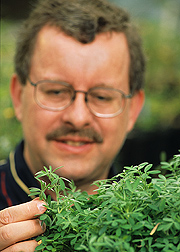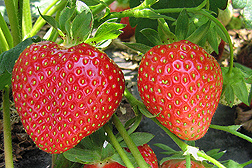A Huge Plus for Breeders, Producers—and the Rest of Us
Plant Genomics Research
Systematic study of genetics and plant breeding started in 1856, when Gregor Mendel began to research some of the visible traits in pea plants, like pod size and seed color. His work demonstrated that these traits were heritable—and also proved that they could be altered by human intervention.
ARS scientists now address Mendel’s findings on a much larger scale as they figure out how best to use the nearly half million plant specimens, called “accessions,” stored in gene banks throughout the United States. These accessions are used in plant-breeding efforts throughout the country and around the world.
Grape Genetics as a Model
ARS researchers want to use these accessions more effectively for research and development. So they’ve developed a crucial long-term goal: creation of the National Genetic Trait Index (NGTI). This index will detail the useful genetic variations contained in the entire ARS collection of plant germplasm.
But ARS scientists are starting small—with a proof-of-concept project to index the useful genetic variation of more than 2,000 accessions in the grape germplasm collection. This project will provide much-needed information to grape breeders and producers. It will also demonstrate the importance of obtaining this genetic information for all plant accessions in the ARS collections.
|
|
The grape genome was sequenced in 2007, an accomplishment that yielded a wealth of information about European grapes (Vitis vinifera), the specialty crop with the highest market value in the United States. Grapes are a long-lived, heterozygous perennial with a diverse germplasm pool, which may contain traits breeders could use to enhance grape disease and pest resistance, fruit quality, and stress tolerance. But even though commercial marker-assisted breeding is often used for major field crops, relatively little information is currently available to grape breeders.
In their new project, ARS researchers will locate thousands of single nucleotide polymorphisms (SNPs) throughout the grape accessions. They will also evaluate bioinformatic techniques for identifying SNPs in crops that—unlike grapes—haven’t been fully sequenced and don’t have a “reference genome” available to help researchers locate SNPs. This advance will facilitate the application of the NGTI concept to other important crops.
Ed Buckler is a plant geneticist in the ARS Robert W. Holley Center for Agriculture and Health (RWHC) (formerly the U.S. Plant, Soil, and Nutrition Laboratory) in Ithaca, New York. He will collaborate with ARS scientists at Geneva, New York; and Davis, California, to genetically characterize many of the Vitis accessions. Their work will include analysis of both domesticated and wild grape varieties.
Buckler notes that, historically, the biggest problem for genomics research has been discovering the functional genetic variation in and among accessions. Functional variation occurs when a gene acquires a mutation that alters the expression of a specific trait.
“We want to create a SNP index to thousands of functional variants in the grape genome,” he says. “This will mean finding molecular markers for some 2,000 different grape accessions and figuring out how the different accessions are related to each other. Then we can start figuring out the relationships between the molecular data—the genotypes—and the trait data—the phenotypes.”
Buckler has several collaborators in this multiyear effort, which began early in 2008. RWHC computational biologist Doreen Ware will conduct quality-control analysis of the grape genome data. She will use the genome data and an estimated 350,000 available grape expressed sequence tags (ESTs) to find likely SNPs for further study.
This will enable grape geneticists to start connecting molecular diversity with trait variation and study how phenotypic variation of a trait—like flowering time or berry size—is associated with these SNPs. Results will eventually be added to the ARS Germplasm Resources Information Network database.
“The most rewarding part of this grape genomics study is that we now have the tools in hand to use this genetic information efficiently,” Ware says. “As a result, we’ll be in a very good position to deal with grape-breeding challenges in the next 5 to 30 years.”
|
|
Other ARS scientists involved in this project include Geneva plant geneticists Charles Simon and Gan-Yuan Zhong and Ithaca plant physiologist Leon Kochian. Simon, who is the curator of the Geneva grape germplasm collection, will expand the phenotyping of the collection to complement the preceding genomic research.
“To be able to understand the richness of genetic diversity, we need to look at the genome more broadly,” says Zhong, who is eager to see the long-range effects this information will have on grape-breeding efforts. “It’s very exciting that ARS has committed support to this project, in which we are trying to translate discoveries into practical, applicable opportunities.”
Developing Wheat That Can Battle Pathogens and Stress
ARS has also established four regional small grains genotyping laboratories to assess and improve varieties grown in different production environments. This genomics research lets wheat breeders “stack” traits for increased resistance to pathogens and stress and enables them to rapidly screen seeds and seedlings for useful characteristics.
|
|
Plant molecular geneticist Guihua Bai oversees molecular wheat-breeding efforts at the ARS Plant Science and Entomology Research Unit in Manhattan, Kansas. Researchers at this regional lab are looking for beneficial traits in hard winter wheat accessions from breeding programs in six Great Plains states.
Bai says that a major concern for wheat breeders and producers in this region is aluminum toxicity caused by acid soils. His lab has identified a new tolerance gene from a Chinese germplasm accession and several DNA markers associated with different aluminum-tolerance genes in wheat. The DNA markers have been used to screen for aluminum resistance in many wheat-breeding programs.
If wheat cannot be harvested on time because of prolonged wet weather, the seed may germinate in the head—another major concern for producers and breeders. Bai’s team is looking for DNA markers associated with genes that regulate preharvest sprouting. They’ve already located two genes linked to this trait, one of them in a variety of hard winter wheat from the United States. Bai believes this may prove to be especially valuable to regional breeders and producers because it originated from U.S. domestic wheat.
Bai says they have a hard time keeping up with all the breeders’ requests for their genotyping evaluations. “We look at physiological traits, quality traits, and disease traits that usually cannot be easily determined in the field at the same time,” says Bai. “With one piece of leaf tissue, we can analyze 30 traits from that tissue sample simultaneously.”
In Pullman, Washington, geneticist Deven See manages the ARS Western Regional Small Grains Genotyping Laboratory, which also furnishes wheat and barley breeders with genetic profiles of germplasm. See says breeders and producers in the Pacific Northwest are particularly interested in developing varieties of wheat that have resistance to stripe rust disease.
Stripe rust can inflict wheat yield losses of up to 40 percent in the Pacific Northwest area. Breeders have traditionally checked for stripe rust resistance by inoculating greenhouse plants with spores and ranking the severity of disease symptoms via visual assessments of physical characteristics—a process that can take months.
With DNA markers, breeders can now use leaf samples to check for resistance within a few days of extraction, independent of stripe rust’s phenotypic or environmental conditions.
“In breeding for elite-adapted cultivars, ensuring that the desired alleles of key traits are present is essential for the next generation of crosses,” See says. He thinks that at least 60 percent of the genotyping requests they’ve received from wheat breeders in five states—Washington, California, Oregon, Idaho, and Montana—are for rust-resistance genes.
In Fargo, North Dakota, scientists at the ARS Cereal Crops Research Unit are providing similar support for breeders and producers in the Northern Plains. Molecular geneticist Shiaoman Chao has been building a wheat genotyping database to house the information from all the ARS regional small grains genotyping centers. She is also leading lab studies on hard spring wheat, spring barley, and durum wheat.
Breeders are particularly interested in using markers to screen for lines resistant to wheat scab, a serious disease caused by the Fusarium fungus. Chao notes that a “perfect marker”—which is typically very hard to locate—for genetic resistance to scab has already been identified by scientists at the University of Minnesota. Another perfect marker has been found for high grain protein content—a valuable trait to breeders and producers—by researchers at the University of California-Davis.
Chao’s team has also identified 240 single sequence repeat markers for determining the genetic diversity of wheat throughout the United States, which will contribute significantly to the creation of robust wheat crosses. They have also genotyped 400 SNP markers in wheat and will continue to work with breeders to associate the SNPs with specific traits.
At the ARS Plant Science Research Unit in Raleigh, North Carolina, plant geneticist Gina Brown-Guedira watches over wheat production on the eastern side of the country. She notes, “Sometimes it’s like running on a treadmill—wheat pathogens can change just as quickly as we can.”
Her team is currently focusing on 15 different traits to breed improved varieties of wheat. She estimates that at least 75 percent of the genotyping requests they’ve received from wheat breeders in 14 eastern states—from Michigan to Louisiana—are for Fusarium-resistance genes and rust-resistance genes. The laboratory has three technicians who run genetic samples all day, and they provide hundreds of thousands of data points to breeders every year.
Brown-Guedira notes that research on wheat genetics lags behind other field crops partly because the wheat genome has not been sequenced yet. But she says that regional wheat breeders are supported by effective working collaborations among researchers at the genotyping labs, plant geneticists, breeders, and producers.
The payoff may come when, for example, U.S. wheat proves resistant to a new cereal fungus. But there is no doubt that research in plant genomics will continue to reap huge benefits for breeders, producers, and consumers around the world.
Buckler, for one, believes ARS contributions will be critical to this transformation. “We have the world’s premier germplasm collection,” he says. “I’d like to see the entire USDA plant germplasm collection utilized the way we’re going to use the grape germplasm collection.”—By Ann Perry and Jan Suszkiw, Agricultural Research Service Information Staff.
This research is part of Plant Genetic Resources, Genomics, and Genetic Improvement, an ARS national program (#301) described on the World Wide Web at www.nps.ars.usda.gov.
To reach the scientists mentioned in this article, contact Ann Perry, USDA-ARS Information Staff, 5601 Sunnyside Ave., Beltsville, MD 20705-5129; phone (301) 504-1628, fax (301) 504-1486.
|
|
Marking Genes for Better ’Beans
Soybeans, America’s second-biggest crop, generate $18 billion annually in farm sales. But about $1 billion worth is lost to soybean cyst nematodes.
The nematodes obstruct the flow of nutrients critical to proper growth and seed development. Farmers plant resistant cultivars, but the pests eventually overcome them by evolving into virulent new forms.
“There’s a constant arms race going on between soybeans and cyst nematodes. That’s why you have to keep breeding new, resistant varieties,” says geneticist David L. Hyten, with ARS’s Soybean Genomics and Improvement Laboratory, in Beltsville, Maryland.
For Hyten and research leader Perry B. Cregan, the arms race takes place along stretches of DNA within soybean’s 20 chromosomes. Since the 1990s, Cregan has delineated these DNA stretches with simple sequence repeats (SSRs) and single nucleotide polymorphisms (SNPs) to flag the chromosomal whereabouts of desirable genes and their alleles.
Cregan’s lab relies on the SNPs to expedite the search for genes that control resistance to pests, including the soybean cyst nematode and soybean rust—a new pathogen on the North American continent.
|
|
With new high-throughput SNP marker technology, many hundreds of SNP markers can be analyzed in 3 days on 192 plants of a population resulting from the mating of a disease-resistant soybean with a susceptible one. This process significantly increases the speed and accuracy of discovering DNA signposts closely associated with resistance genes. These signposts can then be readily applied to soybean breeding to rapidly identify plants that carry pest resistance or other desirable quality or productivity traits.
Cregan estimates they’ve amassed 45,000 markers and mapped the locations of about 15,000 of them. Throughout, his lab has collaborated closely with scientists James E. Specht (University of Nebraska-Lincoln), Randy L. Nelson (ARS, Urbana, Illinois), Randy C. Shoemaker (ARS, Ames, Iowa), H. Roger Boerma (University of Georgia-Athens), Joseph Burton (ARS, Raleigh, North Carolina), Brian W. Diers (University of Illinois at Urbana-Champaign), and others.
The upshot of their efforts will be faster, better, and cheaper soybean breeding for agronomic traits—like mid-oleic oil—and traits for resistance to pests and diseases, such as rust.
“Breeding better beans is really a numbers game,” says Hyten. Of thousands of offspring plants that are screened in breeding programs, only a few are chosen for further development as elite cultivars.
“Currently,” says Cregan, “we’re working to define 50,000 DNA markers in each of the 19,000 soybeans in the USDA Soybean Germplasm Collection so this important resource can be used more efficiently.”—Jan Suszkiw, Agricultural Research Service Information Staff.
|
|
Fingerprinting a West Coast Grape Collection
Grape plants from around the globe flourish in vineyards and the screened enclosures, or screenhouses, of an ARS genebank in northern California. Officially known as the National Clonal Germplasm Repository for Tree Fruit and Nut Crops and Grapes, it’s a richly diverse, expanding assemblage of more than 2,800 wild, rare, and domesticated grapes.
Soon, plant geneticist Mallikarjuna Aradhya will have gleaned a genetic fingerprint of each member of the collection. He’s doing that by using what are known as “microsatellite markers.” Eight markers suffice for genotyping more-familiar grapes, like close relatives of those already used for making wine or raisins or for eating out-of-hand.
But the lesser known vines—wild grapes and some prized types from China, for instance—require twice as many markers for their profile. “Grapes’ taxonomy continues to be quite jumbled,” says Aradhya. “Genotyping the collection should help us sort out some basic questions, such as the relatedness of certain species to others.”
What’s more, the grape profiles help researchers and breeders decide which specimens in the collection will best meet their needs. Some will want grapes for basic research; others may want to explore unusual grapes’ commercial potential.
With 600 better known grapes and 300 wild specimens already fingerprinted, Aradhya expects to have the collection fully genotyped in about a year.—By Marcia Wood, Agricultural Research Service Information Staff.
|
|
The Maize Diversity Project
With support from USDA and the National Science Foundation, ARS maize geneticists and breeders at Ithaca, New York; Columbia, Missouri; and Raleigh, North Carolina; are exploring the vast variability in maize worldwide to enhance the genetic base of the U.S. corn crop. They are creating genomics-assisted breeding techniques to help incorporate these genetic traits into the U.S. maize gene pool. The work involves multiple public, private, and academic researchers.
Maize is the most diverse crop species known. On average, two different maize lines can be as genetically different as a human and a chimpanzee. A key aspect of the work is identifying chromosomal regions where exotic maize lines possess genes with agronomic effects superior to those carried in Corn Belt lines.
For the project, ARS computational biologist Doreen Ware and colleagues have produced Panzea, an online bioinformatics resource on maize diversity. Panzea contains millions of data points, providing access to genotype, phenotype, and polymorphism data.
“This resource is vital to distinguishing functional trait differences, such as flowering time and number of kernel rows on a corn cob,” says plant geneticist Dave Marshall, who heads the ARS Plant Science Research Unit in Raleigh, North Carolina. “To understand these differences fully, we need both the phenotypic data, which gives us information about a plant’s environmental influences, and the genotypic data, which tells us about a plant’s inherent genetic differences.”
Panzea is used by federal, university, and private researchers as well as commercial seed companies. The website can be accessed at www.panzea.org.—By Rosalie Marion Bliss, Agricultural Research Service Information Staff.
|
|
Mapping Blueberry Genes
ARS plant geneticist Jeannine Rowland and colleagues have produced and made publicly available an online blueberry genomics database, called “BBGD.” Blueberry is now a major berry crop with significant nutritional and economic value, and plant breeders strive to create plants that can adapt to a wide range of soils, climates, harvest techniques, and environments.
The researchers are with the Genetic Improvement of Fruits and Vegetables Laboratory in Beltsville, Maryland. To date, they have identified gene sequences and molecular markers of horticultural significance and put that information on the BBGD for marker-assisted breeding and transformation.
|
|
Blueberry plants set flowerbuds in the summer and fall that develop into fruit the following summer. But extremely low winter temperatures and early spring frosts can kill those buds, leading to reduced crop yield and losses.
The database provides key information on gene expression related to a cultivar’s ability to acclimate to and survive cold winters—a critical step to good summer yields. The online information on increased gene expression during exposure to cold will help breeders produce blueberry cultivars with enhanced winter hardiness. To access BBGD online, go to http://psi081.ba.ars.usda.gov/bbgd/index.htm.—By Rosalie Marion Bliss, Agricultural Research Service Information Staff.
|
|
Genotyping for Tomato Quality
ARS plant geneticist John Stommel, at the Genetic Improvement of Fruits and Vegetables Laboratory in Beltsville, Maryland, is identifying genes in wild species of tomato that might increase the quality of cultivars.
Within these tomato genotypes, Stommel is identifying multiple locations—or loci—where genes related to specific traits are found. These loci include gene variants that may be exploited to enhance fruit quality attributes related to tomato fruit firmness and rot resistance.
Firmness is important for tomato fruits grown for both fresh-market sales and processed foods, because it helps them withstand the rigors of harvest and shipping.
Stommel is identifying the number and location of these genes of interest within the 12 chromosomes of the wild species’ genomes. “Some traits are controlled by single genes and are simply inherited,” says Stommel. “But others are controlled by numerous genes and are called ‘quantitatively inherited traits.’”
Stommel seeks links between a trait and the loci where its governing genes occur, and then uses statistical analysis to assess the relationship between phenotype and genotype.
Using diverse tomato breeding lines, Stommel evaluated fruit firmness attributes through both compression and puncture tests. The results from both tests suggested that superior genotypes could be produced by combining, in one genotype, the genes that positively influence firmness.—By Rosalie Marion Bliss, Agricultural Research Service Information Staff.
|
|
Evaluating Germplasm for Potential Industrial Uses
In Griffin, Georgia, long-term work on genotyping and phenotyping the germplasm collection maintained by ARS’s Plant Genetic Resources Conservation Unit is under way. Led by Gary Pederson, unit scientists are applying DNA markers to genotype accessions of chile pepper, cowpea, lespedeza, sweet sorghum, sweetpotato species, switchgrass, and other important crops in the collection at Griffin. They’re also recording phenotypic descriptor data on all accessions undergoing seed regeneration, including annual clover, chile pepper, cowpea, cucurbits, peanuts, warm-season grasses, and watermelon.
The potential agronomic value of many of the legume species in the Griffin collection hasn’t been estimated. Griffin researchers are now evaluating the content and variability of various legume phytochemicals for possible applications, including pest control.
“Many underutilized specialty legumes hold promise for uses in biological control of pests—as well as in nutraceutical or medicinal products and biofuels,” says Pederson.
Castor beans aren’t legumes, but their hulled seeds contain an easily extracted oil that’s widely used in printing, dyeing, and machine lubrication. Its 90-percent ricinoleic acid content imparts characteristics that help make castor oil ideal for biodiesel. “But the genetic diversity of castor bean has never been evaluated,” says Pederson.
The Griffin researchers will assess the genetic diversity of their castor accessions and evaluate them for seed yield, oil content, and fatty acid composition that is best for biofuel production and for other uses.—By Sharon Durham, Agricultural Research Service Information Staff.
Coming to a Screen Near You: New Wheat Genotypes!
Thousands of pieces of young, carefully preserved leaves often show up in Shiaoman Chao’s morning mail.
That’s not unusual. Chao is, after all, one of ARS’s plant genotyping experts, and the little leaf pieces are just some of the many samples she and her colleagues at the agency’s three other genotyping labs regularly receive.
These snippets are sent by wheat and barley breeders across the country who are anxious to see whether the progeny of their plant-breeding programs have what it takes to succeed.
Results go not only to these proud parents but also to a database that Chao is designing and building. It houses the genotypic results generated at her Fargo, North Dakota, lab, as well as from the others.
Chao plans—with breeders’ cooperation—to make the database public. She’s working toward that goal with ARS scientists in the Genomics and Gene Discovery Research Unit, part of the ARS Western Regional Research Center at Albany, California. This team, led by geneticist Olin D. Anderson, curates the massive GrainGenes database, where Chao’s multilab database would become a resource that more people could access and search.
It’s an apt choice of Web venue. Grain breeders and others already know GrainGenes as a treasure trove of genetic information about wheat, barley, and other small grains, like rye, oats, and triticale. (See “GrainGenes Website Speeds Discovery of Familiar Grains’ Unfamiliar Genes,” Agricultural Research, May/June 2008, pp. 20-21.) Making the genotype results available there, says Chao, “means they’ll be widely available—as quickly as possible.”
The GrainGenes Web site can be accessed at http://wheat.pw.usda.gov.—By Marcia Wood, Agricultural Research Service Information Staff.
|
|
Mapping Berry Fruit Genes
At the Genetic Improvement of Fruits and Vegetables Laboratory in Beltsville, Maryland, ARS plant geneticist Kimberly Lewers is studying the genetic control of repeat fruiting in strawberry, blackberry, and raspberry. Repeat fruiting has been an extremely valuable trait to the strawberry industry in California and areas with similar mild climates. “The goal in these climates, and now also on the East Coast and in the Midwest, is to develop a combination of cultivars and production systems that together produce fruit nearly year round,” she says.
Lewers has been analyzing data she received from collaborators at Michigan State University in East Lansing who crossed a June-bearing strawberry cultivar with a repeat-fruiting cultivar. Plants from the resulting seedling population were observed by ARS, university, and industry collaborators for their flowering habit throughout the growing season in Michigan, Minnesota, Maryland, Oregon, and California.
They found that the genetic control of repeat fruiting was different in strawberry plants grown in relatively hotter Maryland climates than those grown in the milder, West Coast climates of Oregon and California.
ARS plant geneticist Chad Finn, with the Horticultural Crops Research Unit in Corvallis, Oregon, collaborated on this research. Finn and Lewers will use the findings from this research model to predict which seedlings in their breeding programs will be capable of repeat fruiting.—By Rosalie Marion Bliss, Agricultural Research Service Information Staff.
"A Huge Plus for Breeders, Producers—and the Rest of Us: Plant Genomics Research" was published in the August 2008 issue of Agricultural Research magazine.









